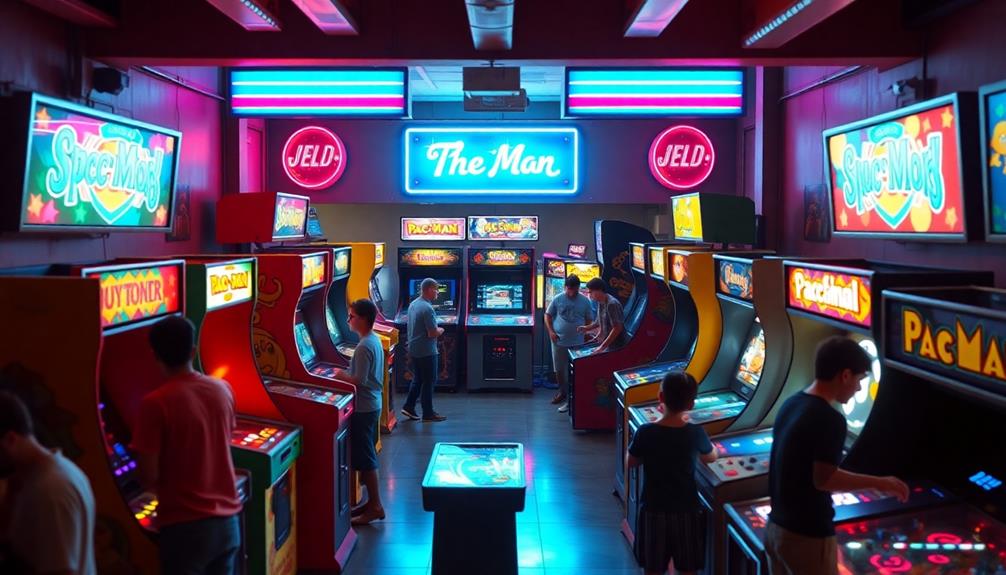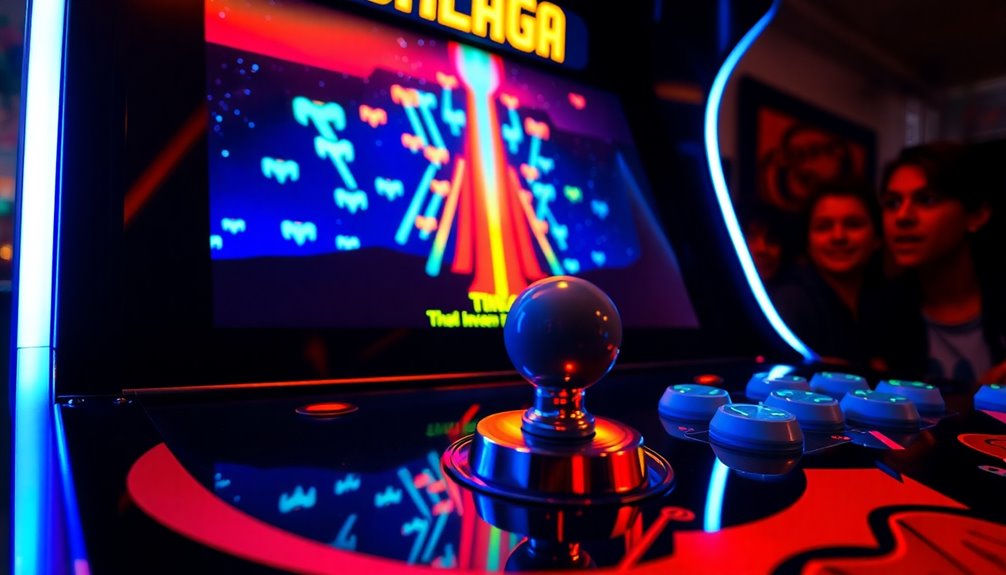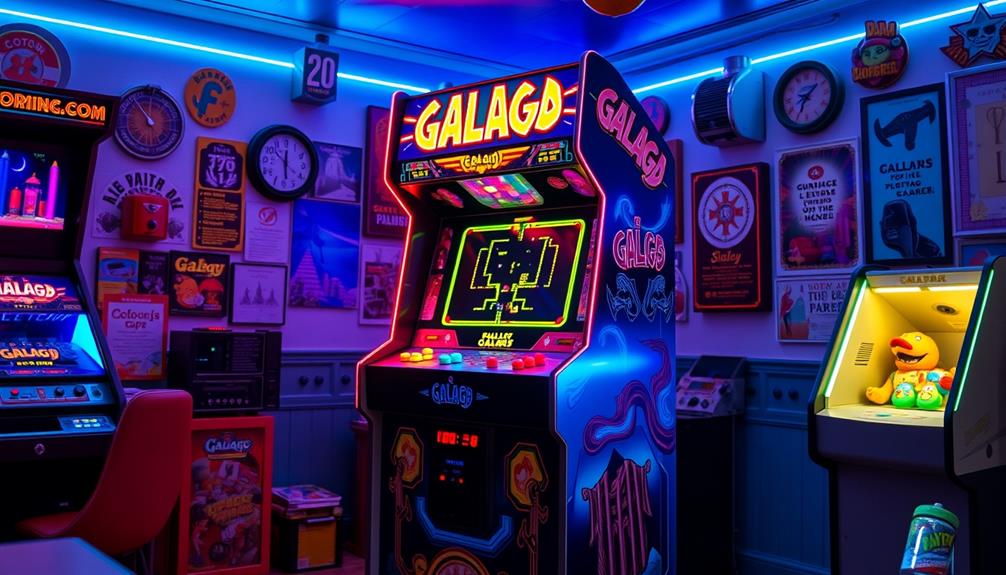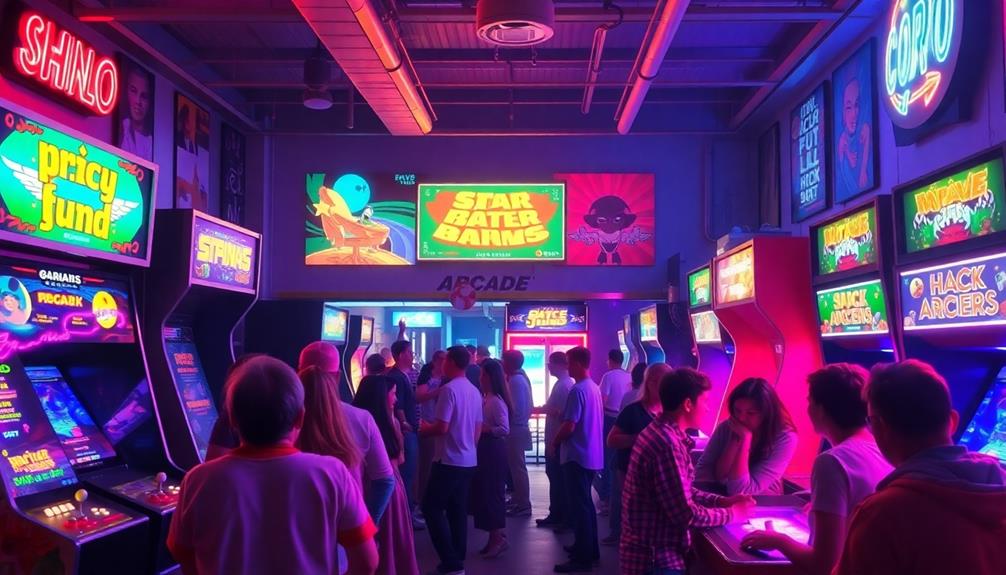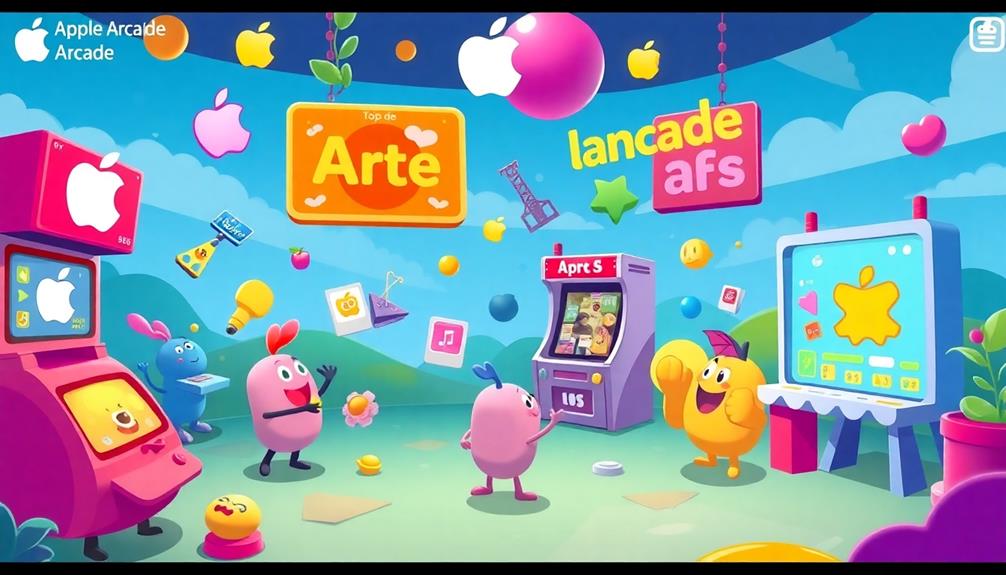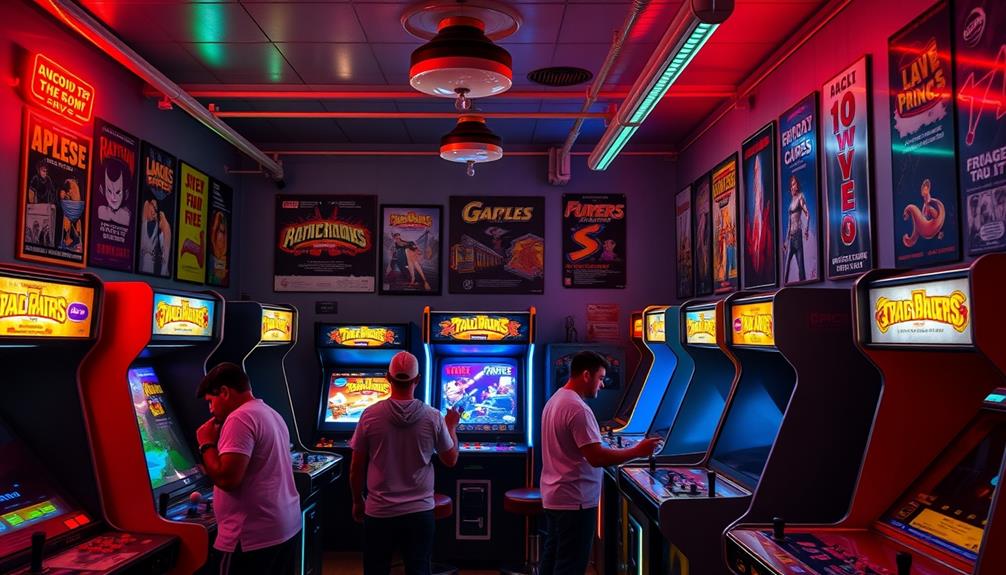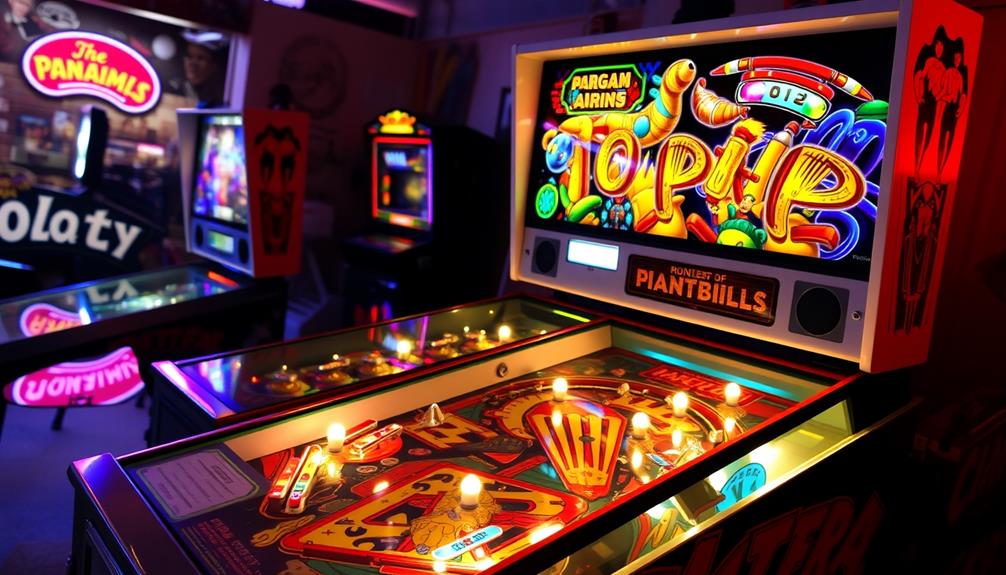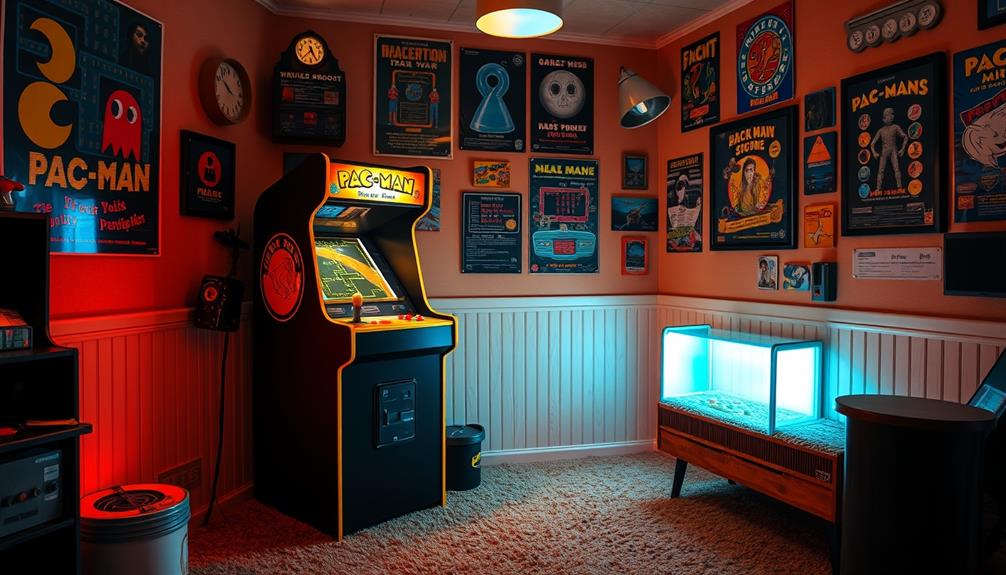Classic arcade games are the iconic titles that revolutionized gaming in the late 1970s and 1980s, such as Pac-Man, Donkey Kong, and Galaga. These games introduced groundbreaking gameplay mechanics and captured players’ attention with their innovative designs. Players navigate with skill, engage in strategic shooting, and enjoy cooperative play, all within vibrant, colorful environments. Arcades became a cultural phenomenon, shaping not only the world of gaming but also popular culture. Today, you can relive these classics through emulators and barcades, sparking feelings of nostalgia and community. Stay tuned to learn more about their lasting impact and the evolution of gaming.
Key Takeaways
- Classic arcade games emerged in the late 1970s, featuring iconic titles like *Pac-Man*, *Donkey Kong*, and *Galaga* that shaped gaming culture.
- These games introduced innovative gameplay mechanics, influencing the development of various genres such as platforming, maze chase, and shoot-em-up.
- Arcade gaming became a cultural phenomenon, significantly impacting entertainment revenue and leading to the rise of video game journalism.
- The arcade industry saw rapid growth in the early 1980s, reaching $8 billion in revenue and surpassing music and film industries.
- Nostalgia for classic arcade games continues today, with retro gaming events and merchandise celebrating their legacy and influence on modern gaming.
Overview of Classic Arcade Games
Since the late 1970s, classic arcade games have captivated players and shaped the gaming landscape. With over 500 titles released between 1977 and 1997, these iconic games like *Ms. Pac-Man*, *Donkey Kong*, and *Galaga* not only defined their genres but also introduced innovative gameplay mechanics.
During the arcade gaming boom, you experienced a surge of diverse gameplay styles that set the foundation for modern gaming. Their cultural impact is similar to how Nikki Reed and Ian Somerhalder promote a sustainable lifestyle as a couple, influencing broader trends.
Today, you can relive these nostalgic gameplay experiences through emulators like MAME, which allow both retro gamers and newcomers to enjoy these classics. The cultural impact of classic arcade games is undeniable; they influenced not just game design but also popular culture in ways still felt today.
Their legacy continues to resonate, reminding you of the creativity and innovation that sparked an entire industry.
Whether you're aiming for high scores or just enjoying the challenge, classic arcade games offer an engaging slice of gaming history. Immerse yourself in this world and discover how these titles have shaped your favorite modern games, all while enjoying the thrill of gameplay that's stood the test of time.
Key Titles and Their Impact

Classic arcade games have left an indelible mark on the gaming industry, with key titles shaping gameplay mechanics and player experiences. *Pac-Man* (1980) became a cultural icon, selling over 400,000 cabinets and grossing more than $1 billion by 1981. Its maze chase gameplay appealed to a broad audience, setting a new standard in game design.
Additionally, the integration of modern technology in arcade machines has allowed for enhanced gameplay experiences, making them more accessible for casual gamers and serious enthusiasts alike, as seen in the best arcade machines available today.
Similarly, *Space Invaders* (1978), which grossed $2 billion by 1982, popularized the shoot-em-up genre, establishing essential arcade game mechanics that influenced many successors.
Meanwhile, *Donkey Kong* (1981) introduced platform gaming and iconic characters like Mario, paving the way for future platformers. This title sold over 132,000 cabinets, demonstrating its lasting impact.
*Ms. Pac-Man* (1982) built on its predecessor's success with new mazes and smarter enemies, further solidifying the franchise's cultural significance.
Finally, *Galaga* (1981) refined fixed shooter mechanics as a sequel to *Galaxian*, becoming a staple in arcades and enhancing the space shooter genre.
These titles not only revolutionized gameplay but also fostered a community around arcade gaming, showcasing the power of classic arcade games in shaping the industry as we understand it today.
Evolution of Game Genres
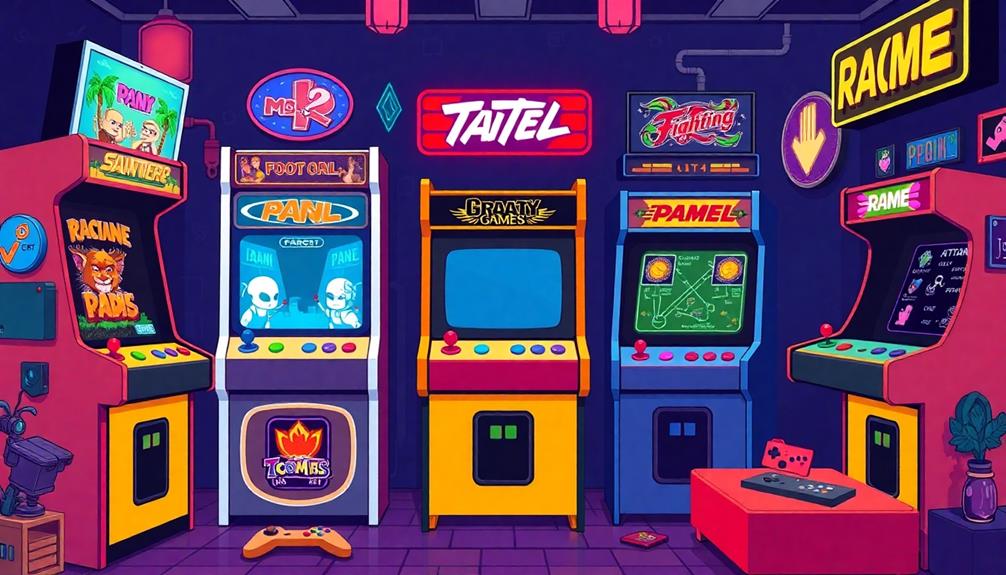
Arcade games have always evolved, reflecting changes in technology and player preferences. Starting with *Pong* in 1972, the competitive sports games genre laid the groundwork for more complex game mechanics. With the introduction of *Pac-Man* in 1980, the maze chase genre emerged, diversifying arcade offerings and attracting a broader audience.
The platforming genre took off with *Donkey Kong* in 1981, bringing characters and narratives into gameplay, while skill-based games like *Qix* shifted the focus to timing and strategy. This evolution showcased the potential for varied experiences within arcades.
Technological advancements, such as RGB color graphics and digital audio, fueled innovation, leading to iconic titles like *Tempest* and *Galaga*. Here's a glimpse at how these genres have transformed over time:
| Genre | Key Title | Year |
|---|---|---|
| Competitive Sports | Pong | 1972 |
| Maze Chase | Pac-Man | 1980 |
| Platforming | Donkey Kong | 1981 |
These developments highlight how arcade games not only adapted to new technologies but also shaped player experiences, paving the way for future innovations.
Gameplay Mechanics and Innovations

Innovative gameplay mechanics have been at the heart of classic arcade games, driving player engagement and shaping the gaming landscape. Titles like *Space Invaders* introduced multiple life systems, allowing you to continue playing even after losing all your lives, enhancing your persistence.
The maze chase dynamics of *Pac-Man* pushed you to skillfully navigate through intricate mazes while avoiding relentless enemies, setting a standard for future maze-style games. Similarly, the excitement found in modern pinball machines showcases how gameplay has evolved, with a focus on high-quality experiences and advanced technology that keeps players coming back for more (best rated pinball machines).
With *Donkey Kong*, platform gaming emerged, introducing jumping mechanics and obstacles that demanded precise timing and skillful navigation. This created a new genre that captivated players seeking challenges.
Additionally, cooperative gameplay in *Gauntlet* allowed you and your friends to team up, emphasizing teamwork and strategy, enriching the arcade gaming experience.
Technological advancements during this golden age, such as RGB color graphics and digital audio, greatly enhanced the immersive experience, making player interaction more engaging than ever.
These innovations not only defined the classics but also laid the groundwork for future games. By blending unique gameplay mechanics with evolving technology, classic arcade games left a lasting impact on how you interact with gaming today.
Cultural Influence on Society
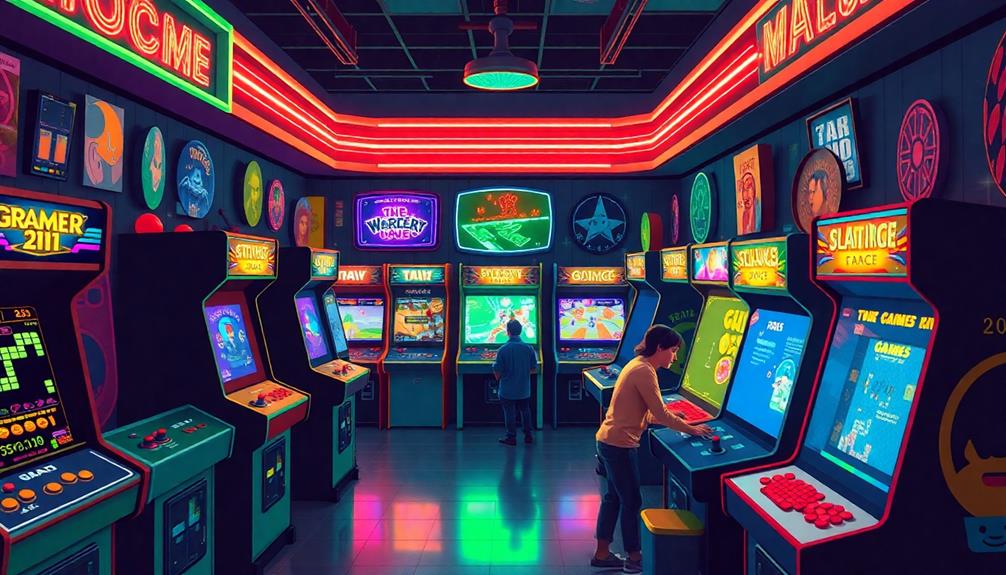
The explosion of arcade gaming in the late 1970s and early 1980s reshaped popular culture in ways that are still felt today. Arcade games like *Space Invaders* not only captured your attention but also altered the entertainment landscape markedly, paralleling the enchanting ceremonies of recent celebrity weddings like Billy Gilmans Secret Wedding.
This cultural impact sparked phenomena such as "Pac-Mania," which revolutionized merchandising and media representations of video games. Here are some key influences:
- Shift in Entertainment: The rise of arcade games led to a $400 million drop in the music industry's revenue, showing how gaming changed entertainment preferences.
- Everyday Life: A national shortage of 100 yen coins in Japan highlighted how deeply arcade games penetrated daily routines.
- Media Representation: Films like *Tron* and TV shows like *The Goldbergs* embedded gaming culture into the fabric of 1980s pop culture.
- Emergence of Gaming Discourse: Video game journalism flourished, shaping early discussions around gameplay and influencing gaming culture.
Iconic Characters and Stories
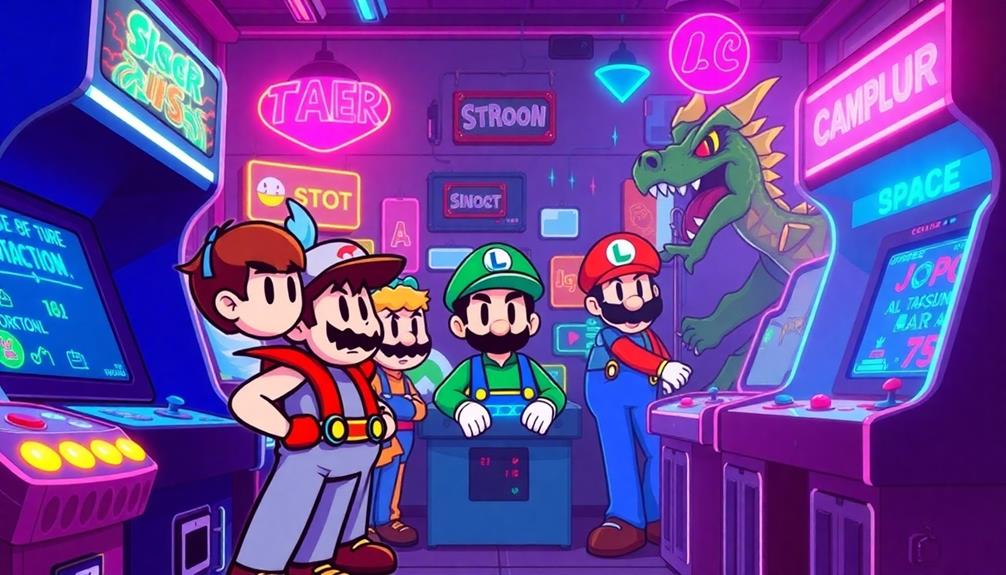
From traversing mazes to rescuing loved ones, iconic characters and engaging stories in classic arcade games have left an indelible mark on gaming culture. Take Pac-Man, for instance. You guide this iconic character through intricate mazes, munching on pellets while dodging ghosts. Its narrative captivated a wide audience, including women and non-gamers.
Similarly, Donkey Kong introduced Mario (originally Jumpman) as he attempts to save his girlfriend, Pauline, from the clutches of the titular ape, establishing a storyline that laid the foundation for Nintendo's franchise. These games not only entertained but also fostered social interactions, akin to unique party options enhance celebrations that bring people together.
Ms. Pac-Man enhanced the original game with new mazes and a female protagonist, showcasing intelligent enemy behavior that expanded the game's lore.
On a different front, Galaga immerses you in a space battle, where you defend Earth against waves of alien ships, blending gameplay with a compelling narrative of heroism.
The Business of Arcade Gaming

In the early '80s, the arcade gaming industry saw incredible revenue growth, skyrocketing from $50 million to $900 million in just three years.
This surge not only reflected the booming popularity of diversification strategy in entertainment options but also highlighted how innovative game design attracted a wide audience.
As you explore this boom, consider how the rise in arcade machines and their cultural significance reshaped the entertainment landscape.
Understanding these market dynamics reveals why arcade gaming became a dominant force in both revenue and popular culture.
Revenue Growth Trends
During the golden age of arcade gaming, revenue growth trends skyrocketed, with arcade machine sales jumping from $50 million in 1978 to an impressive $900 million by 1981. This surge was a clear indicator of the booming arcade video game industry, which saw a significant shift in how people engaged with entertainment, similar to the impact of global operations disruptions experienced during major outages.
By 1982, the U.S. arcade industry revenue reached an astounding $8 billion in quarters, showcasing the massive popularity of arcade games. Video games dominated the commercial game sales, accounting for 87% of the $8.9 billion total that year.
Here's a quick breakdown of the revenue growth trends:
- Arcade machine sales: From $50 million (1978) to $900 million (1981).
- U.S. arcade industry revenue: $8 billion in 1982.
- Video games market share: 87% of $8.9 billion in commercial game sales (1982).
- Combined revenue: Estimated between $11.8 billion and $12.8 billion for arcade and home video games (1982).
These figures reflect not just economic impact but also the cultural significance of arcade games, surpassing even the revenue of pop music and Hollywood films in 1982.
Market Expansion Dynamics
The arcade gaming industry witnessed an extraordinary market expansion throughout the early 1980s, fueled by a surge in both consumer interest and technological advancements. This growth was a prime example of how high-quality content boosts credibility, as the innovative designs and gameplay of arcade machines captured the imaginations of players.
From 1980 to 1982, the number of video game arcades doubled, peaking at 10,000 across North America. This rapid growth encouraged arcade machine sales to skyrocket from $50 million in 1978 to an impressive $900 million by 1981. By 1982, the U.S. arcade industry generated a staggering $8 billion in revenue from quarters alone, surpassing the combined revenue of the music and film industries.
Video games played a pivotal role in this expansion, constituting 87% of the $8.9 billion in commercial game sales that year. The combined revenue of the arcade and home video game market in 1982 ranged between $11.8 billion and $12.8 billion, showcasing the industry's immense potential.
As you explore classic arcade games, it's crucial to recognize how the market dynamics shaped this golden era. The innovations and popularity of arcade games not only transformed entertainment but also laid the groundwork for the future of gaming.
Legacy and Nostalgia Today

Classic arcade games have a unique power to evoke nostalgia, drawing in both seasoned gamers and newcomers alike. These iconic games like *Pac-Man* and *Donkey Kong* not only shaped your childhood but also continue to influence modern gaming culture. Their cultural impact is celebrated through various means, including:
- Merchandise: You can find countless products that pay homage to these classic titles.
- Retro gaming events: These gatherings allow fans to relive the magic with others who share the same passion.
- Barcades: Adult-oriented entertainment venues blend nostalgic gameplay with social experiences, making it easy to enjoy while grabbing a drink.
- Classic Arcade Gaming tournaments: These events highlight the competitive spirit of arcade gaming, inviting participants who cherish the thrill.
The legacy of classic games is also reflected in the evolution of other genres and gaming mechanics, such as those seen in the history of pinball machines.
The revival of arcade cabinets guarantees that these timeless games remain accessible. Companies are reintroducing modern versions, appealing to both long-time fans and newcomers.
This blend of nostalgia and innovative design keeps the legacy alive, enriching the experiences of players today while influencing the next generation of games. Classic arcade games truly embody a bridge between the past and the present, celebrating their enduring appeal. Many players find retro arcade games to be a refreshing break from the hyper-realistic graphics and complex gameplay of modern titles. The simplicity and charm of these vintage games have a timeless quality that continues to captivate new audiences. Despite the advancements in technology, the magic of retro arcade games remains unparalleled in the gaming world.
Popular Game Variants and Sequels

Building on the nostalgia of classic arcade games, popular game variants and sequels have emerged to keep the spirit alive while offering fresh experiences. These adaptations introduce new challenges and gameplay mechanics, making them appealing to both veterans and newcomers alike.
| Game Title | Key Features | Gameplay Type |
|---|---|---|
| Ms. Pac-Man Plus | Altered maze designs, smarter enemy AI | Enhanced Original |
| Donkey Kong Junior | Control Donkey Kong's son, rescue missions | Unique Mechanics |
| Galaga 3 | New levels, power-ups, retains core mechanics | Fixed Shooter |
| Dig Dug II | Focus on digging, new enemy defeat mechanics | Modified Original |
| Super Space Invaders | Enhanced graphics, new gameplay features | Upgraded Classic |
In Ms. Pac-Man Plus, the smarter AI transforms the gameplay, while Donkey Kong Junior offers a fresh perspective on the original story. Galaga 3 keeps the fixed shooter charm alive with new levels, and Dig Dug II changes the game by focusing on digging rather than simple enemy defeat. Finally, Super Space Invaders enhances the classic with updated visuals and features, ensuring that the legacy of classic arcade games continues to thrive.
Future of Classic Arcade Games

Many enthusiasts are excited about the future of classic arcade games, as they continue to evolve and capture the hearts of both old and new players. The rise of barcades has made nostalgic gaming experiences more accessible, merging social activities with beloved games.
Just as the cruise industry has adapted to changing consumer preferences, the landscape of classic arcade gaming is changing due to several factors:
- Innovations in Game Design: Manufacturers like Raw Thrills and LAI Games are releasing new titles that blend classic gameplay with modern technology, offering unique experiences for gamers.
- Competitive Gaming: Tournaments and events focused on arcade-style play are drawing both seasoned veterans and newcomers into the fold.
- Retro-Themed Events: Special gatherings and celebrations foster community among enthusiasts, reviving interest in gaming culture.
- Industry Networking: Trade shows and seminars are essential for showcasing innovations, ensuring classic arcade games stay relevant.
With these trends, the future looks bright for classic arcade games. Whether you're participating in a competitive tournament or enjoying a drink at a barcade, there's no shortage of opportunities to experience the joy of nostalgic gaming.
Frequently Asked Questions
What Was the Original Arcade Game?
The original arcade game is *Computer Space*, released in 1971. You'll find it fascinating how this game laid the groundwork for future arcade classics, paving the way for the vibrant gaming culture we enjoy today.
What Is Considered an Arcade Game?
An arcade game's a coin-operated machine providing quick, skill-based gameplay. You insert coins, control characters, and aim for high scores. These games often feature simple mechanics, making them easy to pick up yet hard to master.
What Was the First Popular Arcade Games?
When you think of the dawn of arcade gaming, *Pong* springs to life, a simple dance of pixels. Its popularity ignited a revolution, paving the way for iconic titles that followed and reshaped entertainment forever.
What Is the Highest Selling Arcade Game of All Time?
The highest-selling arcade game of all time is *Pac-Man*. You'd find its iconic cabinets in nearly every arcade, contributing to over 400,000 units sold and generating more than $1 billion in revenue by 1981.
Conclusion
In the vibrant tapestry of gaming history, classic arcade games stand as timeless gems, shimmering with nostalgia and innovation. They've shaped not just the gaming landscape but also our culture, weaving connections among generations. As you step into an arcade, the familiar sounds and pixelated graphics invite you to relive epic battles and high scores. While the future beckons with new adventures, the spirit of these classics will always spark joy, reminding us of the magic that started it all.

